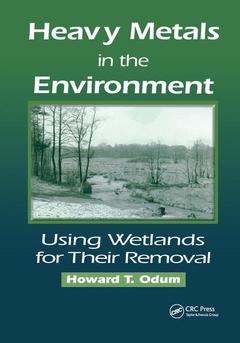Heavy Metals in the Environment Using Wetlands for Their Removal
Coordonnateur : Odum Howard T.

Much of the convenience of modern life resides in sheet metal, the cowling shield of most machines and appliances. However, the load that this takes off human shoulders has to be carried elsewhere, and the Earth has borne the burden. Many of us woke up to the environmental cost when over a century of industrialization finally surpassed the capacity of nature to assimilate it.
International in scope, Heavy Metals in the Environment: Using Wetlands for Their Removal discusses wetland functions and heavy metal contamination. It addresses such questions as: Can systems powered by sunlight handle toxins more effectively than systems running on fossil fuel? At what scale and by what means do we define efficiency? These questions resonate increasingly with a number of global challenges.
As inescapable as climate change, you can no longer avoid airborne toxins, acid rain, and polluted water by moving away from them. When the time comes to rely less on fossil fuel-based technology, how will we clean up the aftermath of toxic misadventures?
Written by a leader in the growing field of ecological engineering, Heavy Metals in the Environment: Using Wetlands for Their Removal presents scientific studies that illustrate how natural systems use wetlands to adapt to changes in the ecosystem. It focuses primarily on lead, one of the first materials used by developing civilizations and a metal used heavily in the industrial era. The goal: to achieve a better understanding of how natural systems use wetlands to adapt to wastes.
Contents
Introduction and Background. Lead in a Cypress-Gum Swamp, Jackson County, Florida. Lead and Wetlands in Poland. Value and Policy. Appendices. References.
Date de parution : 09-2019
17.8x25.4 cm
Date de parution : 05-2000
Ouvrage de 320 p.
17.8x25.4 cm
Thèmes de Heavy Metals in the Environment :
Mots-clés :
CRC Press LLC; Emergy Evaluation; Biogeochemical Cycle; Earth Cycle; Humic Substances; Pe Rc; Lead; Nymphaea Odorata; E10 Sej; Appendix A5; SAPP; Leaded Gasoline; Lead Concentrations; Money Ratio; Heavy Metals; Air Pollution; Acid Mine Drainage; Wetland Treatment; Ppm Lead; Sewage Sludge; Solar Emergy; RF; Appendix Table A6; Leaf Area Index; Solar Emjoules



